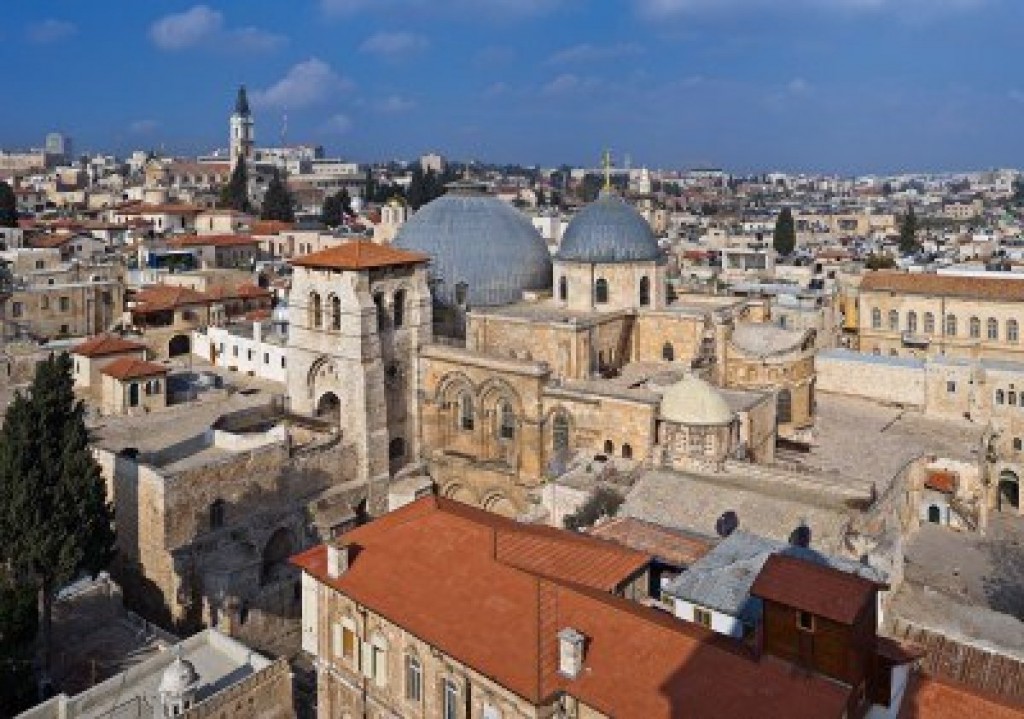
Several people have called my attention to this story, which is quite appropriate for the Christmas season (and will be even more appropriate for Easter):
“Age of Jesus Christ’s Purported Tomb Revealed”
I posted the following blog entry slightly more than a month ago, but it seems worth reposting in the light of the two articles above:
A poignant passage about Jerusalem’s Church of the Holy Sepulcher from the late Reverend Dr. Jerome Murphy-O’Connor, O.P. (1935-2013), a Roman Catholic and a Dominican priest who was, for decades, a professor of New Testament at the illustrious École Biblique there in that city:
One expects the central shrine of Christendom to stand out in majestic isolation, but anonymous buildings cling to it like barnacles. One looks for numinous light, but it is dark and cramped. One hopes for peace, but the ear is assailed by a cacophony of warring chants. One desires holiness, only to encounter a jealous possessiveness: the six groups of occupants — Latin Catholics, Greek Orthodox, Armenian Orthodox, Syrians, Copts, Ethiopians — watch one another suspiciously for any infringement of rights. The frailty of humanity is nowhere more apparent than here; it epitomizes the human condition. The empty who come to be filled will leave desolate; those who permit the church to question them may begin to understand why hundreds of thousands thought it worthwhile to risk death or slavery in order to pray here.
Is this the place where Christ died and was buried? Yes, very probably.
Jerome Murphy-O’Connor, The Holy Land: An Oxford Archaeological Guide from Earliest Times to 1700 (New York: Oxford University Press, 1993)
I’m privileged to have interacted with Father Murphy-O’Connor when he once spent a week or two at Brigham Young University, teaching a kind of “master class” to some of the faculty, and to have had an email conversation with him for a while thereafter. I had and have enormous respect for him as both a scholar and a man. So I’m moved by his response to the Church of the Holy Sepulcher, which (having been there more times than I can count) I completely understand.
For a long time, I found it easy to ignore the place, religiously speaking. On the other hand, its historical importance is impossible to overlook. Originally built in the early fourth century by the Roman emperor Constantine the Great at the instigation of his mother, St. Helena, atop the ruins of a second-century temple constructed by his pagan predecessor Hadrian to the goddess Aphrodite or Venus; almost completely destroyed by the Fatimid caliph al-Hakim bi-Amr Allah (an important figure in my doctoral dissertation, though for mostly unrelated reasons) in the early eleventh century; ostensibly, at least, the principal object of the Crusades; regarded by much of Western Christendom as the center of the world, toward which all maps were (literally) oriented — it’s one of the most important buildings on our planet, even from a secular perspective. (And I’ve barely scratched the surface of its remarkable history.)
Is it the site of Christ’s tomb? Virtually all Christians and most authorities believe it to be so. And I myself went through a period of believing that very likely. (I’ve long since concluded that, for all its desirable qualities — it’s a rare location in Jerusalem where peaceful meditation is feasible, for instance, and it can’t be more than a few hundred yards from the right place — the Garden Tomb almost certainly cannot be the burial site of Christ.) More recently, though, an article by my friend and BYU colleague Jeff Chadwick (“Revisiting Golgotha and the Garden Tomb”) has impelled me to conclude that the Holy Sepulcher isn’t the right spot, either.
But it’s been venerated by hundreds and hundreds of thousands of very earnest pilgrims for nearly two millennia, and that alone, in my judgment, is enough to make it a place of holiness and a site deserving of great respect.
I’ve been to Jerusalem again, and have visited the Holy Sepulcher (and the Garden Tomb) yet again, since writing the lines just above. While there last month, I had a brief conversation about the Holy Sepulcher with Professor Matthew Grey of the Brigham Young University faculty, who is teaching this year at BYU’s Jerusalem Center for Near Eastern Studies. He’s persuaded me to think yet again about the possibility that the Holy Sepulcher is, indeed, the place of Christ’s burial and resurrection.
I think it’s safe to say that very few, if any, of the Latter-day Saint scholars who have given serious attention to the archaeology of the Garden Tomb believe it to be the right place. And, in my experience, most of them lean instead toward the Church of the Holy Sepulcher or — to give it the Arabic name that I much prefer — Kinisat al-Qiyama, “the Church of the Resurrection.”












